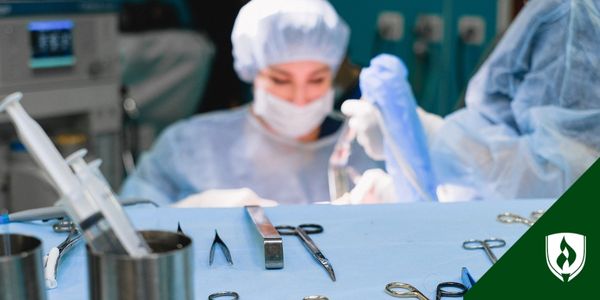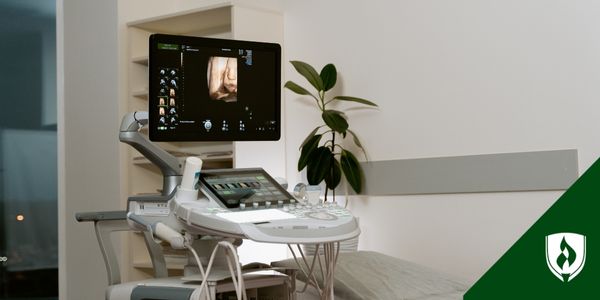What Does a Medical Assistant Do? A Closer Look at This Caring Career
By Brianna Flavin on 03/01/2019

Working in healthcare has always sounded like an appealing option for you—but the path to actually doing it is a different story. Getting into a program, years of college work and residencies just aren’t in the cards for you as you’ve got a lot on your plate already. But there are a few options for those who want to work in healthcare with less of an upfront investment.
Becoming a medical assistant is one intriguing option—but before you get too far along in making any career decisions, you’d like to learn more about the role and what medical assistants do on a daily basis. Put simply, a medical assistant is the healthcare professional that keeps busy hospitals and clinics running smoothly. In this article, we’ll take a closer look at what that entails and how it may vary depending on the setting—so let’s get right into it.
What does a medical assistant do, exactly?
Wondering what these healthcare pros do during each shift? We created this short video to provide you with a high-level look at what a medical assistant does. Take a look and keep reading below for even more info.
What Does a Medical Assistant Do?
Role of a medical assistant
“Medical assistants have a very diverse and wide skill set,” says Rasmussen University Medical Assisting department chair Denise Pufall. “They are a great support to a medical practice by having the ability to perform both patient care duties and both front- and back-office duties.”
This broad skill set is fairly unique in a medical setting—most roles are focused squarely on either the patient care side or the administration side. Medical assistants play a hand in both.
The clinical side of medical assisting translates most directly to recording vital signs when interacting with patients, compiling patients’ medical histories and administering medications under direction of a supervising physician. In the administrative realm, medical assistants can be responsible for everything from scheduling appointments to billing and assisting patients in filling out insurance forms.
“They streamline the process and make the practice extremely efficient,” Pufall says. As the healthcare industry scrambles to cut costs, professionals who can boost efficiency are a crucial pillar of the future.
Top medical assisting skills
“Medical assistants need to be compassionate, understanding, good listeners and problem solvers,” Pufall says. “They need to adapt to change quickly and be able to take direction from physicians and other members of the patient support team.” Being quick on the uptake is also vital in this role that often fills last-minute needs in a healthcare facility.
What else is important for medical assistants to know? To answer that, we analyzed over 95,000 medical assistant job postings to identify the top skills employers were looking for were:1
- Patient care
- Scheduling
- Vital signs measurement
- Communication skills
- Computer literacy
- Organizational skills
Medical assistants who find work in specialized facilities (e.g., dialysis centers, nursing homes, outpatient surgical centers) might need extra skills and knowledge applicable to their environment.
For a more detailed look at important skills in medical assisting, check out, “Medical Assisting Skills: What You Need to be Confident in Your Career.”
Medical assistant job settings
As of 2016, most medical assistants worked in doctor’s offices, according to the Bureau of Labor Statistics (BLS). Other major employers were hospitals and outpatient care centers.2
“Medical assistants are hired in areas that include phlebotomy, EKG technicians and medical administration,” Pufall says. Professionals in these settings might have other titles though they are still using their medical assisting skills.
While jobs in doctor’s offices and hospitals make up the bulk of medical assistant employment, there are certainly opportunities to be found in facilities that might not be top-of-mind.
“Other healthcare facilities that are starting to utilize medical assistants include dental offices, chiropractic offices and both long- and short-term healthcare centers and nursing home facilities,” Pufall says. The work setting and schedule for medical assistants is highly dependent on their employer. Those who work in a hospital or long-term care facility can expect to work certain weekends and holidays. Those who work in a clinic will probably work during standard business hours.
What does a medical assistant do in a clinic?
In a clinic, rather than specializing in a specific unit or wing of a big hospital, medical assistants’ work is more comprehensive, filling in any gaps as needed.
In small clinics, medical assistants are often referred to as “generalists” because they do everything from greeting patients and answering telephones to changing wound dressings and removing sutures. They also instruct patients about general care, medicinal procedures and special diets. Electronic health records (EHRs) are changing some medical assistants’ jobs, according to the BLS. Most MAs will have regular interaction with EHR software and will need to learn the system their office uses.
This blend of routine administrative and clinical duties helps keep everything running smoothly, a role highly valued by the office managers, physicians, nurses and other health practitioners in the clinic.
What does a medical assistant do in a hospital?
A medical assistant working in a hospital will have many of the same duties—clerical work, EHR management and patient interaction are still key. The specific duties assigned to medical assistants working in a hospital, however, are dependent on the needs of their unit.
The balance between administrative and clinical work is still very evident. Medical assistants in a hospital handle callers and drop-ins, schedule procedures, coordinate billing, help with paperwork and more. The clinical side of the job can be both patient-based and laboratory-based.
While direct patient needs, such as administering medication or immunizations, are an important part of the job, medical assistants in hospitals may also spend time in the lab examining blood, urine and stool samples.
Is a medical assisting career in your future?
So, what does a medical assistant do? A lot! Medical assistants work to make life easier for both physicians and patients. And the good news is that it doesn’t have to stop there if you decide that healthcare is something you really love.
Now that you know what a medical assistant does, take the step to see if you can translate the skills you’ve acquired as a parent into the skills you’ll need in medical assisting.
Wherever you aim to work, a career as a medical assistant could be the perfect way to find steady employment in the healthcare industry without needing to commit to years and years of education first. In fact, a Medical Assisting Diploma can be completed in as few as 12 months.3 For a few more details on what it takes to get started in this vital healthcare career, check out our article, “How to Become a Medical Assistant: 5 Steps You Can't Ignore.”
1Source: Burning-Glass.com (Analysis of 97,130 medical assisting job postings, Jul. 01, 2017 – Jun. 30, 2018).
2Bureau of Labor Statistics, U.S. Department of Labor, Occupational Outlook Handbook, [information accessed February, 2019] www.bls.gov/ooh/. Information represents national, averaged data for the occupations listed and includes workers at all levels of education and experience. Employment conditions in your area may vary.
3Completion time is dependent on the number of transfer credits accepted and courses completed each term.
EDITOR'S NOTE: This article was originally published in March 2014. It has since been updated to include information relevant to 2019.




